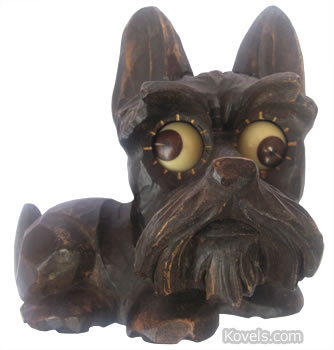Q: I have a wooden clock shaped like a dog. The eyes roll and tell the time. It still runs and dates back to approximately the 1920s. It’s marked “S” on the bottom. Can you tell me something about this clock?
A: Wooden, plastic, and plaster rolling-eye clocks were made from the late 1920s until the 1960s and are popular collectibles today. J. Oswald was granted a patent for the rolling-eye mechanism in 1926 and many of the early clocks were made by the J. Oswald Co. of Freiburg, Germany. Before World War II, most rolling-eye clocks were made of wood. In the 1950s and ’60s, clocks were made of molded plaster or other material. Clocks shaped like a dog are the most common. Owl-shaped clocks were also popular. Clocks shaped like cats, lions, other animals, and people were also made. The eye on the left side of the clock (the dog’s right eye) shows the hour and the eye on the right (the dog’s left eye) shows the minute. The time shown on your clock is 9:20. It’s not possible to tell who made your clock, but many early wooden clocks were made by Oswald and not all of them were marked. A figural rolling-eye clock sells for about $400.




I’ve never seen anything like this before…how cute!
Does it work?
I would think a wall-sized collection of these would be worth quite a bit more than the price of this individual pup suggests.